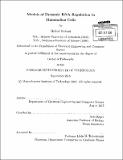| dc.contributor.advisor | Aviv Regev. | en_US |
| dc.contributor.author | Rabani, Michal | en_US |
| dc.contributor.other | Massachusetts Institute of Technology. Department of Electrical Engineering and Computer Science. | en_US |
| dc.date.accessioned | 2014-02-10T16:59:38Z | |
| dc.date.available | 2014-02-10T16:59:38Z | |
| dc.date.issued | 2013 | en_US |
| dc.identifier.uri | http://hdl.handle.net/1721.1/84894 | |
| dc.description | Thesis (Ph. D.)--Massachusetts Institute of Technology, Department of Electrical Engineering and Computer Science, 2013. | en_US |
| dc.description | Cataloged from PDF version of thesis. | en_US |
| dc.description | Includes bibliographical references (pages 135-142). | en_US |
| dc.description.abstract | Complex molecular circuits, consisting of multiple intertwined feedback loops and non-linear interactions, are a hallmark of every living cell, and a model of a dynamic complex network. Here, I systematically study the dynamic changes in the cellular circuits that control RNA levels in mammalian cells, focusing on the model response of immune dendritic cells to pathogens, through an integration of comprehensive computational models and innovative empirical approaches. I establish a computational framework to follow the dynamics of processes for RNA birth (production, by transcription), maturation (processing), and death (degradation), and their integration in the dynamic RNA life cycle. I study the kinetics of a gene's RNA population with a model of its production and degradation, and generalize the system as an ensemble of genes. I further model genes as composite particles and study the regulation and kinetics of altering their internal structure. To allow robust statistical inference from these models, I develop innovative laboratory assays and collect extensive experimental data on the system. I directly measure RNA production rates by coupling short RNA metabolic labeling with advanced RNA quantification. I leverage recent improvements in RNA quantification by next-generation sequencing technology, to significantly increase the resolution of metabolic labeling in both time and gene-structure. Finally, I collect perturbation data, by monitoring RNA levels when specific elements of the network are disabled. In this way, I formulated several general principles of RNA regulation and its temporal evolution in mammalian cells. I find that temporal changes in production provide a dominant input in computing RNA levels by the cell over time. Yet, dynamic degradation changes contribute to shaping expression peaks, and dynamic processing changes allow a fast accumulation of mature transcripts. Static degradation and processing rates vary between genes and between individual splicing junctions, consistently with their function and expression dynamics. This study is broadly applicable to many normal as well as diseases misregulated cellular networks, and is also relevant for a more general analysis of complex systems dynamics. | en_US |
| dc.description.statementofresponsibility | by Michal Rabani. | en_US |
| dc.format.extent | 142 pages | en_US |
| dc.language.iso | eng | en_US |
| dc.publisher | Massachusetts Institute of Technology | en_US |
| dc.rights | M.I.T. theses are protected by
copyright. They may be viewed from this source for any purpose, but
reproduction or distribution in any format is prohibited without written
permission. See provided URL for inquiries about permission. | en_US |
| dc.rights.uri | http://dspace.mit.edu/handle/1721.1/7582 | en_US |
| dc.subject | Electrical Engineering and Computer Science. | en_US |
| dc.title | Models of dynamic RNA regulation in mammalian cells | en_US |
| dc.title.alternative | Models of dynamic Ribonucleic Acid regulation in mammalian cells | en_US |
| dc.type | Thesis | en_US |
| dc.description.degree | Ph.D. | en_US |
| dc.contributor.department | Massachusetts Institute of Technology. Department of Electrical Engineering and Computer Science | |
| dc.identifier.oclc | 868825521 | en_US |
